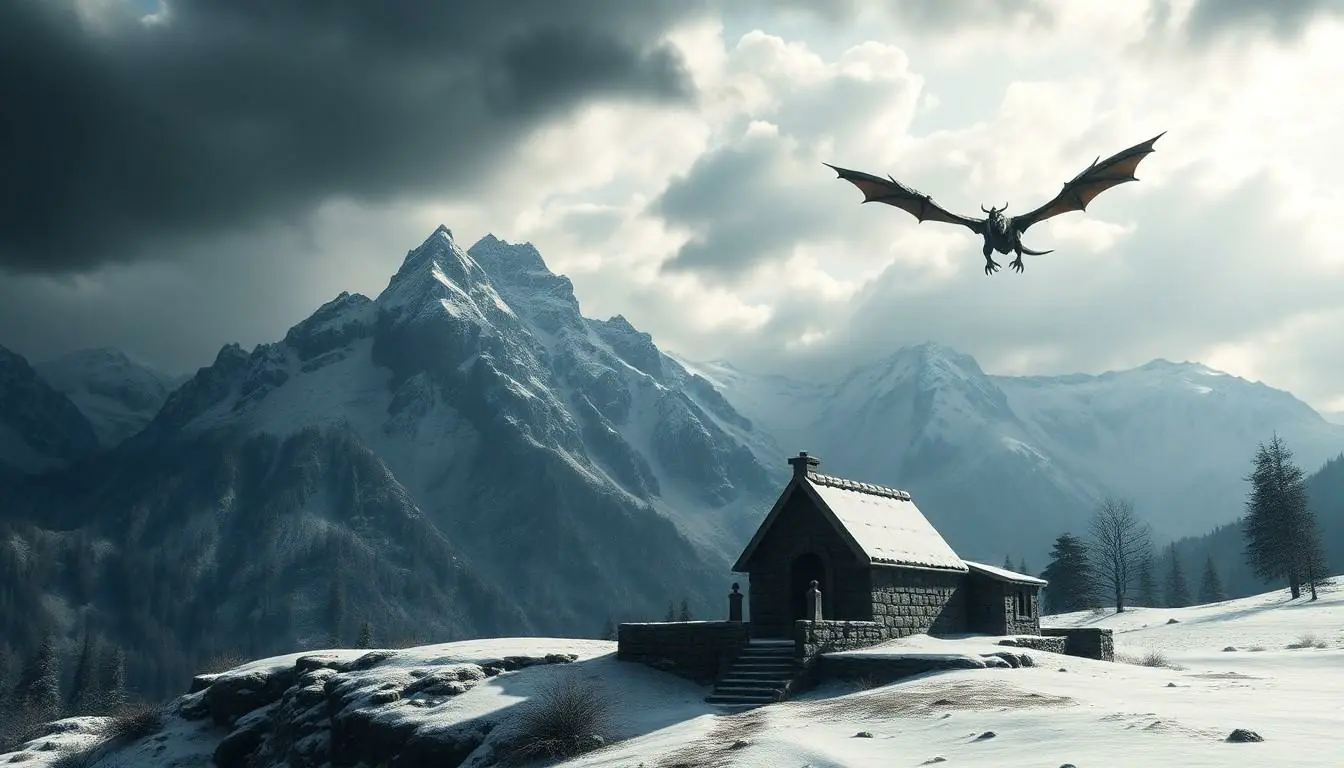In the vast, snow-capped mountains of Tamriel lies a treasure trove of stories waiting to be uncovered. Skyrim isn’t just a game; it’s a rich tapestry woven with dragons, ancient gods, and the occasional awkward encounter with a talking mudcrab. For adventurers and lore enthusiasts alike, delving into the depths of Skyrim’s history is like unearthing a hidden dragon shout—exhilarating and a little bit dangerous.
From the legendary Dragonborn to the enigmatic Thalmor, every character and event adds layers to a world that feels alive and breathing. Whether you’re a battle-hardened Nord or a sneaky Khajiit, understanding the lore enhances the experience, making every quest feel like a chapter in an epic saga. So grab your sword, or perhaps a cup of mead, and get ready to explore the fascinating stories that make Skyrim a timeless classic.
Table of Contents
ToggleOverview of Skyrim Lore
Skyrim boasts a complex narrative shaped by its history, geography, and cultures. Dragons play a pivotal role, representing both terror and the mythic past of Tamriel. Characters like the Dragonborn embody the struggle between good and evil, allowing players to become heroes in a rich tapestry of conflict.
The timeline of Tamriel spans several eras, detailing significant events that influenced the cultures and factions within Skyrim. For instance, the Fourth Era, marked by the return of dragons, significantly alters political dynamics. Various groups, such as the Stormcloaks and the Imperials, engage in a civil war that reflects broader themes of power, loyalty, and freedom.
Divine beings, known as the Aedra and Daedra, inhabit the lore, impacting mortal lives in myriad ways. The Nine Divines, worshiped by many, include deities like Talos, whose worship ignites controversy due to political ramifications following the White-Gold Concordat. Daedric Princes, such as Mehrunes Dagon and Azura, provide quests that explore moral ambiguity and the human condition.
Cultural elements significantly enrich gameplay. Nord traditions, such as mead-making and the reverence for ancestors, create a unique atmosphere. The architecture of cities like Whiterun and Solitude reflects their histories and values, offering players deeper immersion.
Exploring Skyrim involves unraveling ancient mysteries, from the Falmer to the Thalmor. Each quest intertwines with the overarching narrative, making players integral to the unfolding saga. Engaging with Skyrim’s lore enhances the gaming experience, immersing players in a world filled with depth and storytelling.
Major Races in Skyrim
Skyrim features a variety of races, each contributing to the world’s rich lore and diverse culture. The Nords, Elves, and Humans play pivotal roles in shaping Skyrim’s narrative.
Nords
Nords are the primary inhabitants of Skyrim. Characterized by their strength, resilience, and warrior culture, they thrive in the harsh, cold climate. Lars, a skilled blacksmith, exemplifies the Nord spirit through dedication to craftsmanship. They honor their ancestors and deities, celebrating traditions through feasts and warrior ceremonies. Often depicted as fierce fighters, Nords possess a deep connection to their homeland. The legend of the Dragonborn, a Nord hero, illustrates their legacy of bravery against dragons, emphasizing their role as defenders of Skyrim’s freedom.
Elves
Elves represent a sophisticated and ancient presence in Skyrim. Divided into several groups, including the High Elves and Wood Elves, they embody distinct cultural nuances. High Elves, known for their magical prowess, often seek knowledge and power. Meanwhile, Wood Elves, or Bosmer, are masters of archery and stealth, living harmoniously with nature. Their history with the Nords is complex, filled with both cooperation and conflict. The Elves’ refinement in art and magic contributes significantly to the culture of Tamriel. Various quests involve Elven characters, enriching the player’s understanding of their philosophies and traditions.
Humans
Humans, in addition to Nords, include varieties like Imperials and Bretons. Each group showcases unique traits that define their interactions with Skyrim’s lore. Imperials hail from Cyrodiil, bringing their diplomatic skills and ambition to the region. Bretons, with their strong connection to magic, often stand at the crossroads of political intrigue. Human presence influences various factions, such as the Stormcloaks, showcasing resistance against Imperial control. Their interactions with other races create a vibrant tapestry of culture and conflict within Skyrim. Through quests and interactions, players explore human intricacies and witness their impact on the realm’s evolving story.
Key Historical Events
Understanding the key historical events in Skyrim provides context for its rich lore. Major events have shaped the landscape, politics, and cultures of the game world.
The Dragon War
The Dragon War marks a pivotal conflict between dragons and Nords in Tamriel. It began when dragons, once revered, turned against mortals. As dragons sought dominion, Nords united under legendary heroes such as Jurgen Windcaller. This unity led to the defeat of the dragons and the eventual disappearance of their powerful leader, Alduin. Players may encounter remnants of this war through ancient ruins and dragon shrines scattered across Skyrim, revealing stories of loss and triumph.
The Great War
The Great War erupted between the Aldmeri Dominion and the Empire. This conflict arose after the White-Gold Concordat, which prohibited the worship of Talos. The Dominion’s advantages included superior military strategy and powerful magic, allowing them to advance towards Cyrodiil. The Empire, weakened yet resilient, fought fiercely but ultimately signed the treaty that ended the war. In-game, the ramifications of the Great War echo throughout political tensions, particularly evident in the ongoing civil war between the Stormcloaks and the Empire.
Important Characters
Skyrim’s lore features several significant characters that shape its narrative and gameplay. Each character embodies essential themes and adds depth to the world.
Alduin
Alduin, known as the World-Eater, plays a central role in Skyrim’s storyline. Representing both destruction and rebirth, he is prophesied to bring about the end of days. Players face him as the ultimate antagonist during their quest as the Dragonborn. Having been revered by the dragons as their chief deity, his return triggers fear among the people of Skyrim. Alduin’s defeat symbolizes a triumph over dire circumstances, reflecting the classic struggle of heroism against overwhelming odds.
Tiber Septim
Tiber Septim, often regarded as one of the most influential emperors in Tamriel’s history, unifies the continent under the Empire. Known for his military prowess and political acumen, he transforms the fragmented nations into a cohesive realm. Septim’s legacy, including the establishment of the Septim Dynasty, profoundly impacts Skyrim’s political landscape. His connection to the divine, believed to be Talos, leads to widespread worship even after the White-Gold Concordat. His character embodies themes of power, faith, and the enduring quest for unity.
Paarthurnax
Paarthurnax, a wise and enigmatic dragon, serves as a mentor to the Dragonborn. Residing atop the Throat of the World, he provides insight into the nature of dragons and their history. His past includes serving along Alduin, but he seeks redemption through teaching mortals. Players encounter him as a voice of reason amidst conflict, challenging them to embrace empathy and understanding. His philosophy contrasts yet complements Alduin’s destructive nature, enriching the lore with a narrative of redemption and transformation.
Mythology and Religion
Skyrim’s mythology is rich with divine and legendary figures. The Aedra and Daedra significantly influence the mortal realm, shaping beliefs and traditions across Tamriel. The Nine Divines include deities like Akatosh, the Dragon God of Time, and Mara, the Goddess of Love, guiding the faithful through their teachings.
Temples and shrines scatter throughout Skyrim, providing places for worship and pilgrimage. The cult of Talos stands out among them, symbolizing both devotion and controversy. Worshippers face persecution yet remain steadfast in their beliefs, reflecting the game’s complex political landscape.
Daedric Princes, including Mehrunes Dagon and Azura, present moral dilemmas through their associated quests. Players encounter these entities, each offering unique rewards and challenges. The diverse nature of their domains provides insight into the moral ambiguities within the world of Skyrim.
Nord traditions deeply intertwine with their mythos, honoring ancestors through various practices. The legacy of heroes like Jurgen Windcaller play a vital role in Nord culture, emphasizing valor and unity against the dragon threat. Legends of these heroes inspire players to partake in grand quests and seek honor.
Mythology also manifests in the form of the Dragonborn, regarded as both a savior and a destroyer. The balance of good and evil echoes throughout Skyrim’s stories, creating a captivating narrative. This duality in divine influence showcases the struggle for power and the importance of individual choices in shaping fate.
Players engage with these themes while exploring the vast world, uncovering secrets and enriching their understanding of the lore. Religions, along with cultural beliefs, enhance the immersive experience, driving players to contemplate the impact of their actions. Through myth and faith, Skyrim continues to captivate audiences with timeless storytelling.
The Role of Dragons in Skyrim Lore
Dragons hold a central role in Skyrim’s lore, symbolizing both power and mythic heritage. The return of these majestic creatures in the Fourth Era marks a significant shift in the world. They embody historical conflict, especially evidenced in the Dragon War, where Nords unified against their once-revered allies. Alduin, the World-Eater, symbolizes destruction while also representing rebirth, presenting a duality that enriches the game’s narrative.
Dragons are not mere antagonists; they also contribute to the backdrop of Skyrim’s culture and history. Each dragon serves a purpose within the mythos, with unique abilities, voices, and personalities. Paarthurnax, for example, contrasts with Alduin and offers wisdom, mentoring the Dragonborn and guiding their journey.
The dragon shouts, known as Thu’um, highlight the linguistic power in the lore. Each shout carries historical significance, often invoking awe and fear among mortals. Learning these shouts connects players to the grand heritage of dragons and enhances gameplay.
Interactions with dragons shape the player’s experience significantly. Engaging in battles or forging alliances affects the unfolding narrative, creating a dynamic environment. Players encounter dragon shrines and ancient ruins, serving as reminders of past conflicts and triumphs.
Overall, dragons encapsulate the essence of Skyrim’s epic saga. Their presence intertwines deeply with the game’s history, geography, and political dynamics. Each dragon encountered enriches the player’s journey, merging lore with interactive storytelling that embodies the timeless nature of Skyrim.
Conclusion
Skyrim’s lore offers a profound journey through a world rich in history and myth. Each element from the dragons to the diverse races contributes to an intricate narrative that captivates players. The interplay of power and morality invites deep reflection on choices made throughout the game.
As players navigate this epic saga they become part of a living story that evolves with every quest. The timeless themes of conflict loyalty and redemption resonate beyond the screen enriching the overall experience. Engaging with Skyrim’s lore not only enhances gameplay but also fosters a deeper connection to the world of Tamriel.




